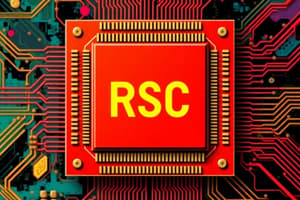Podcast
Questions and Answers
What does the instruction 'bne x10, x11, 2000' do?
What does the instruction 'bne x10, x11, 2000' do?
- It jumps to address 2000 if x10 is not equal to x11. (correct)
- It jumps to address 2000 unconditionally.
- It jumps to address 2000 if x10 equals x11.
- It jumps to address 2000 if x10 is less than x11.
Which component is NOT part of the S format for conditional branch instructions like 'bne'?
Which component is NOT part of the S format for conditional branch instructions like 'bne'?
- rd (correct)
- imm[12:6]
- rs2
- opcode
What is the opcode for conditional branches such as 'bne'?
What is the opcode for conditional branches such as 'bne'?
- 1100001
- 0011101
- 1110000
- 1100111 (correct)
What is the immediate encoding limitation of the jal instruction?
What is the immediate encoding limitation of the jal instruction?
What allows branch instructions to calculate larger program sizes?
What allows branch instructions to calculate larger program sizes?
In the U format for the jal instruction, what is the size of the address immediate?
In the U format for the jal instruction, what is the size of the address immediate?
What is the consequence of the immediate encoding limitation in branch instructions?
What is the consequence of the immediate encoding limitation in branch instructions?
What is the primary advantage of PC-relative addressing in RISC-V?
What is the primary advantage of PC-relative addressing in RISC-V?
What is the encoded distance that the 20-bit address field in jal instruction can represent?
What is the encoded distance that the 20-bit address field in jal instruction can represent?
Which instruction sequence is used for long jumps in RISC-V?
Which instruction sequence is used for long jumps in RISC-V?
What limitation does RISC-V face regarding branch instruction reach?
What limitation does RISC-V face regarding branch instruction reach?
Which of the following ranges can conditional branches in RISC-V typically cover?
Which of the following ranges can conditional branches in RISC-V typically cover?
Why might procedure calls in RISC-V require a more extensive jumping mechanism?
Why might procedure calls in RISC-V require a more extensive jumping mechanism?
What does the PC stand for in the context of branch addressing?
What does the PC stand for in the context of branch addressing?
What is the maximum number of halfwords a RISC-V branch instruction can encode?
What is the maximum number of halfwords a RISC-V branch instruction can encode?
Which addressing mode utilizes a constant embedded within the instruction?
Which addressing mode utilizes a constant embedded within the instruction?
What is the main characteristic of base or displacement addressing?
What is the main characteristic of base or displacement addressing?
In PC-relative addressing, what is added to determine the branch address?
In PC-relative addressing, what is added to determine the branch address?
What is the role of the 'lui' instruction in the RISC-V architecture?
What is the role of the 'lui' instruction in the RISC-V architecture?
If bit 11 of a constant is set in RISC-V immediate instructions, what must be done to handle this case appropriately?
If bit 11 of a constant is set in RISC-V immediate instructions, what must be done to handle this case appropriately?
Which instruction format uses the funct7 field according to RISC-V encoding?
Which instruction format uses the funct7 field according to RISC-V encoding?
What is the maximum positive branch address that can be achieved using the RISC-V branch instruction format?
What is the maximum positive branch address that can be achieved using the RISC-V branch instruction format?
Which of the following is NOT a type of addressing mode used in RISC-V instructions?
Which of the following is NOT a type of addressing mode used in RISC-V instructions?
Which instruction format does RISC-V use for branch instructions?
Which instruction format does RISC-V use for branch instructions?
What is the significance of decoding machine language in the context of RISC-V?
What is the significance of decoding machine language in the context of RISC-V?
What does the opcode field signify in RISC-V instruction encoding?
What does the opcode field signify in RISC-V instruction encoding?
What does the term 'sign-extended' refer to in the context of RISC-V immediate values?
What does the term 'sign-extended' refer to in the context of RISC-V immediate values?
Why might the immediate field size restriction be problematic in RISC-V?
Why might the immediate field size restriction be problematic in RISC-V?
When converting the hexadecimal instruction 00578833 to binary, what is the resulting binary value?
When converting the hexadecimal instruction 00578833 to binary, what is the resulting binary value?
How many bits are used to represent the opcode in the SB-type format of RISC-V branch instructions?
How many bits are used to represent the opcode in the SB-type format of RISC-V branch instructions?
What happens if a register holds a 12-bit immediate value with bit 11 set when using 'addi'?
What happens if a register holds a 12-bit immediate value with bit 11 set when using 'addi'?
What is the primary purpose of synchronization in parallel computing?
What is the primary purpose of synchronization in parallel computing?
What occurs if synchronization is not implemented in a scenario where multiple threads write and read the same memory location?
What occurs if synchronization is not implemented in a scenario where multiple threads write and read the same memory location?
What does mutual exclusion aim to achieve in the context of synchronization?
What does mutual exclusion aim to achieve in the context of synchronization?
What is typically required to implement synchronization mechanisms in a multiprocessor environment?
What is typically required to implement synchronization mechanisms in a multiprocessor environment?
In the analogy of the reporters, why is synchronization important for writing a consistent conclusion?
In the analogy of the reporters, why is synchronization important for writing a consistent conclusion?
Which of the following best describes a data race?
Which of the following best describes a data race?
What role do lock and unlock operations play in synchronization?
What role do lock and unlock operations play in synchronization?
Why are synchronization instructions provided by hardware essential for efficient task coordination?
Why are synchronization instructions provided by hardware essential for efficient task coordination?
Flashcards are hidden until you start studying
Study Notes
Wide Immediates and Addresses
- Large immediate values can be loaded using two instructions:
- lui: Loads the upper 20 bits of the desired value
- addi: Adds the lower 12 bits of the desired value
- RISC-V uses PC-relative addressing for branches and jumps, making it efficient for short jumps.
- For longer jumps, a two-instruction sequence is used:
- lui: Loads the upper 20 bits of the destination address into a temporary register
- jalr: Jumps to the address calculated by adding the lower 12 bits of the destination address to the temporary register
Addressing Modes
- RISC-V supports several addressing modes to access operands:
- Immediate addressing: The operand is a constant within the instruction.
- Register addressing: The operand is a register.
- Base or displacement addressing: The operand is located at a memory location whose address is the sum of a register and a constant.
- PC-relative addressing: The branch address is calculated by adding a constant to the PC.
Decoding Machine Language
- Risc-V machine instructions are encoded in a specific format with opcode, funct3, and other fields.
- By analyzing the bit pattern of a machine instruction, we can determine the corresponding assembly language statement.
Parallelism and Synchronization
- Parallel execution is easier when tasks are independent but often requires synchronization to ensure correct data sharing.
- Data races occur when multiple threads access the same memory location, at least one being a write, and they occur consecutively.
- Synchronization is essential in multiprocessor systems to prevent data races and ensure consistent results in multithreaded applications.
- Lock and unlock operations are used to implement mutual exclusion, allowing only a single processor to access a critical section of code at a time.
- Atomic operations are necessary for synchronization, allowing a read and a write to a memory location without interruption, ensuring consistency in concurrent operations.
Studying That Suits You
Use AI to generate personalized quizzes and flashcards to suit your learning preferences.




